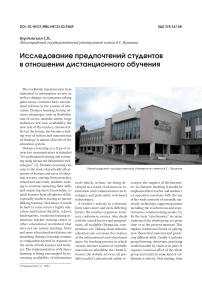Study of student preferences for distance learning
Автор: Burdynskaya S.P.
Журнал: Высшее образование сегодня @hetoday
Рубрика: Дидактика высшей школы
Статья в выпуске: 3, 2023 года.
Бесплатный доступ
The paper provides a brief analysis of the preferences of students of non-linguistic universities in relation to distance learning, their satisfaction with it. The opinion of students about controlled pair and group work, obstacles in work and discomfort experienced by them in a distance lesson is considered. The key role of the presence of a teacher in a distance lesson and the importance of managing its progress are noted. The research ideas that will help teachers effectively conduct online English classes are highlighted.
Distance education, distance learning, synchronous and asynchronous communication models, the role of a teacher in distance learning
Короткий адрес: https://sciup.org/148327087
IDR: 148327087 | DOI: 10.18137/RNU.HET.23.03.P.049
Список литературы Study of student preferences for distance learning
- Белоглазов А.А., Белоглазова Л.В., Мокашов В.В., Копылова П.А. РУДН. Информационно-аналитический бюллетень // Информатизация образования. 2004. № 15(1). С. 38-45.
- Выготский Л.С. Психология развития человека. М.: Смысл; Эксмо, 2005. 1136 с.
- Мингазизова Г.Г. Интеграция мультимедийных технологий в процесс обучения иностранным языкам // Вестник Казанского юридического института МВД России. 2013. № 11. С. 73-77. EDN: QBHNOX
- Мухитдинова М. Р. Effects of Distance Learning on English Language Learning. // Молодой ученый. 2017. № 22(156). С. 183-185. URL: https://moluch.ru/archive/156/44110. EDN: YRMQLT
- Anderson T. Foundations of educational theory for online learning. Theory and Practice of Online Learning. T. Anderson (ed.). 2018. P. 15-44. URL:. DOI: 10.22363/2312-8631-2018-15-1-38-45
- Bernard R.M., Abrami P.C., Lou Y., Borokhovski E., Wade A. et al. How does distance education compare with classroom instruction? A meta-analysis of the empirical literature. Review of Educational Research. 2004. Vol. 3(74). P. 379-439. EDN: JTSWGF
- Perveen A. Synchronous and Asynchronous E-Language Learning. A Case Study of Virtual University of Pakistan. Open Praxis. 2016. No. 8(1). P. 21-39.
- Swan K. Research on Online learning. Journal of Asynchronous Learning Networks. Online learning. 2019. Vol. 11, No. 1. P. 55-59.


